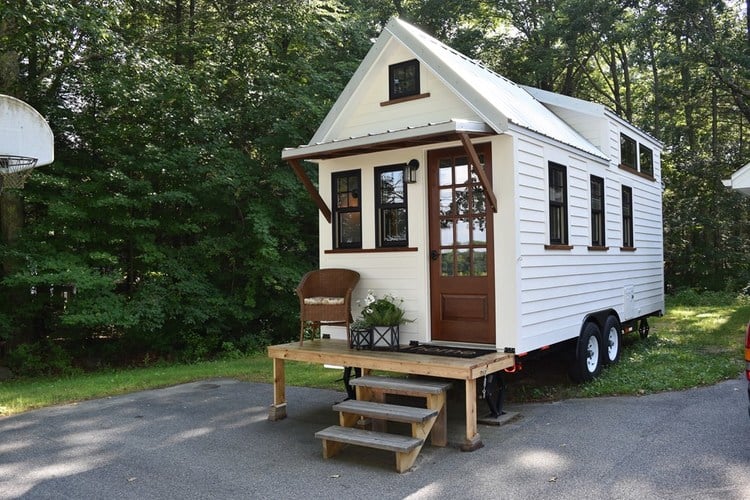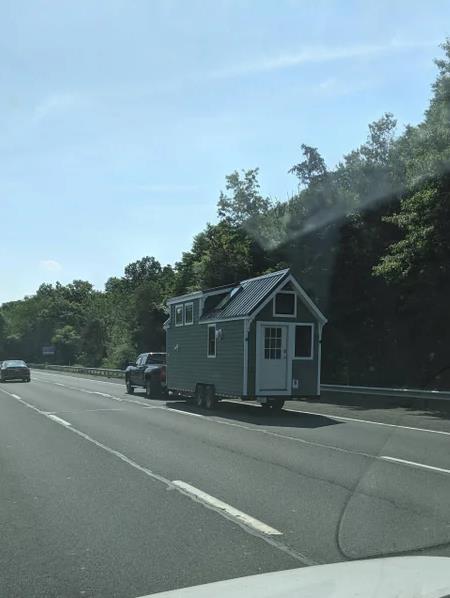Blog

How Portable Are Tiny Houses?
The ‘tiny house dream’ is easy to picture: being able to easily ‘up sticks’ and move your tiny house anywhere in the country, and quickly being able to experience everything that your new destination has to offer. But is this dream really accurate? Are tiny houses on wheels (THOWs) genuinely portable, or are they mainly built this way to circumvent various planning rules?
Most small living enthusiasts actually prefer RVs for travelling, and instead build tiny houses on wheels to circumvent planning rules. However tiny houses are still portable; you just need to be more careful when transporting them.
Legal Status of Movable Tiny Houses
Unlike a tiny house built on foundations (which is generally considered a permanent structure and are subject to building code requirements and inspections), a tiny house on wheels is not subject to the same building codes. Sometimes people build THOWs but never transport them elsewhere, purely to circumvent these building codes.
Nonetheless if you plan to build or own a THOW, it will be important to check with any zoning requirements. A conversation with an experienced local real estate attorney who is familiar with the questions surrounding a tiny house will be important to make sure any zoning standards are met (although they are most like an RV and hence are usually treated as such).
Some jurisdictions will not allow full time occupancy and permit only camping or temporary use. Often there is a limit on the number of nights the tiny house can be occupied. Instead of a building code, there are standards published by the Recreational Vehicle Industry Association that govern RVs and campers which are often applied to a tiny house on wheels. If locating “off the grid”, most (but not all) RV parks welcome tiny houses.
Before Transporting Your THOW
Whether you are buying a tiny house or moving an existing one to a new or different location, you will have to decide between using a professional moving service and doing the move yourself. No matter which option you choose, you will need to make an investment in time and effort to do a successful house move.
If the exterior width of the tiny house is greater than 8-1/2 feet, you should seriously consider a professional moving company. The logistics can become complicated because a wide load requires use of flags and pilot cars. All permits must be obtained before the moving process begins.

If you have a smaller tiny house and if you have had experience pulling a house trailer or camper, and have access to a heavy-duty truck, moving your own tiny house could be realistic. However if you have no experience in driving a truck pulling a trailer, or if you will be moving over back country roads, working with a professional company may be a better solution than attempting to do the move yourself.
If you have decided to do the move yourself, confirm that any truck you would be using for the move has adequate power to tow the house. Some truck rental companies are reluctant to rent a truck for use in towing a tiny house on a trailer. Pulling a tiny house with an underpowered truck can be disastrous.
What does moving a tiny house by yourself entail? Once you have decided on a destination and have planned your preliminary route, you can contact the Division of Motor Vehicles (DMV) in the states through which you will be driving. The DMVs will be able to provide you with specific information on any legal requirements for moving a tiny house. Legal limits on length and width and stops at weigh stations along the way may apply to your circumstances. There are usually permit fees required every time you cross a state line.
Some states can also require that you stop for an inspection when you enter their state. The staff at the DMVs involved can help you ensure that you have the proper registration and permits. Review your basic route so you can obtain the proper permits and check for any local restrictions you have to follow. Work with your insurance company so you have adequate coverage and insurance documentation for the move.
Transporting a Tiny Home
Before you begin driving, make sure that the tiny house and its contents are safely secured. Avoid the temptation to leave items in cabinets. While it does take some time, you may want to pack up anything that is movable and make sure your belongings are secure. Sliding glass doors and windows should also be locked.
You should get familiar with your destination. Will your proposed move and placement of a tiny house be required to follow any zoning requirements or guidelines? Is there anything that needs to be done for the placement of the tiny house? Do you need to clear any trees or brush? Is there a driveway? Is the proposed placement for the tiny house leveled and prepared? Are there any utility hook-ups that are necessary? Once you are familiar with the location and have reviewed the route you would take, you should pay particular attention to width and height overpass clearances, changes in pavement, road grades or tight switchbacks.
Next on the list is to make sure that any prep work at the original site and the destination site is done. This means that any trees or bushes that would interfere with moving the tiny house have been cleared out of the way. If you are starting from a tiny house factory or commercial building site, prep work at the start of the move should be at a minimum. On the other hand, any prep work for the destination may not done until you have arrived and are ready to place the tiny house. Before you begin your drive, make sure you trim any trees or brush that would interfere with moving the house. Make sure any utilities are connected and disconnected properly at each site. Have a ladder and a chainsaw available to use if it becomes necessary to clear a path.
If you are doing the move yourself, it is helpful to have a passenger in the front seat of the towing vehicle with the driver. They can help watch for traffic and check clearances. This is especially helpful when turning. Having another car following directly behind the trailer is also helpful for the same purpose. Cell phones can be used to coordinate any gas or meal stops.
Make sure you are familiar with the roads and the route you will have to take with the tiny house. Investing time to drive the proposed route is helpful to check and confirm any challenges. Paying attention to changes in pavement, clearances through underpasses, changes in grades, tight switchbacks and “slow traffic pull off” areas where you can pull over to let other traffic pass, are all important for a safe trip. If you are driving near or through an urban area, avoid rush hours. Unless you are experienced in pulling a large trailer, consider stopping if the weather turns stormy.
Once you have reached your destination site, make sure the site is properly prepared for the tiny house. Utility hookups should be taken into consideration and you will need room to maneuver the trailer and the house. If you are moving the tiny house to a rural or wilderness area, be aware of private roads and roads that are narrow and have soft or non-existent shoulder. It may take a little more time, but you will benefit in the long run by being a good neighbor.
If you do decide to move your tiny house on your own, make sure you think through the project from start to finish, you have the proper documentation and permits with your, you have any permission needed to drive on private road and you pay attention to any local restrictions.
Technical Practicalities
In addition to the earlier advice, you should also be mindful of the following building and technical practicalities before and after moving your THOW:
- Do not insulate your walls with batts (fiberglass) roll insulation, since this can collapse and fall down the inside of your wall during the move. Either use paper-backed batts and staple this to the drywall, or use something like foam board insulation which is rigid in nature.
- Inspect the underside of your trailer before setting off (ensuring that all welds and mechanic fixings are in a good state), along with ensuring that any bolts and screws inside your house are tight.
- A steel framed tiny home is unconventional, but well worth it compared to timber since steel is lighter but stronger, giving added piece of mind when moving.
- Ensure that your trailer, suspension and axles are all rated higher than the weight of your tiny house. You want some overhead in the figures, too, in-case you buy some heavy furniture or white goods.
- Do not build the home with more overall pin weight than your truck’s payload capacity, and equally make sure that your truck is rated higher than your trailer weight.
- Install window shutters (cheap plywood/OSB works just fine) to protect against any flying objects breaking your windows in transit.
- A gooseneck shape is usually better for tiny houses weighing over 10,000 lbs.